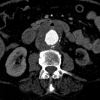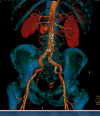Acute Conditions Caused by Infectious Aortitis
- PMID: 26798723
- PMCID: PMC4682749
- DOI: 10.12945/j.aorta.2014.14-004
Acute Conditions Caused by Infectious Aortitis
Abstract
Infection of the aorta is rare but potentially very dangerous. Under normal circumstances the aorta is very resistant to infections. Following some afflictions, the infection can pass to the aorta from blood or the surrounding tissues. The authors present their 5-year experience with therapy of various types of infections of the abdominal aorta.
Methods: In the 5-year period between January 2008 and December 2012, the Surgical Clinic of the University Hospital in Pilsen treated 17 patients with acute infection of the abdominal aorta. They included 9 males and 8 females. The mean age was 73.05 years (58-90). The most common pathogens were Salmonella (7), Staphylococcus aureus (2), Klebsiella pneumoniae (1), Listeria monocytogenes (1), and Candida albicans (1). Two cases included mixed bacteria and no infectious agent was cultured in three cases. In 14 cases (82.6%) we decided on an open surgical solution, i.e., resection of the affected abdominal aorta, extensive debridement, and vascular reconstruction. In all of these 14 cases we decided on in situ reconstruction. Twelve cases were treated using silver-impregnated prostheses. An antibiotic impregnated graft was used in one case and fresh aortic allograft in one case. In one case (5.9%) we decided on an endovascular solution, i.e., insertion of a bifurcation stent graft and prolonged antibiotic therapy. In two cases (11.8%) we decided on conservative treatment, as both patients refused any surgical therapy.
Results: Morbidity was 47.2% (8 patients). In one case we had to perform reoperation of a patient on the 15th postoperative day to evacuate the postoperative hematoma. The 30-day mortality was 5.9% (1 patient). The hospital mortality was 11.8% (2 patients). One patient died on the 42nd postoperative day due to multiorgan failure following resection of perforated aortitis. During follow-up (average 3.5 years), we had no case of infection or thrombosis of the vascular prosthesis.
Conclusion: Patients with mycotic aneurysms or acute aortitides face a high risk of death. One can legitimately expect an increase of "aortic infections" to parallel the increase of immunocompromised individuals. Surgical procedures for infectious aortitis are always demanding and require excellent interdisciplinary cooperation, but, as this experience shows, can lead to midterm survival.
Keywords: Aneurysm; Aortic infection; Aortitis; Pseudoaneurysm; Ruptured aortic aneurysm.
Figures





References
LinkOut - more resources
Full Text Sources
Other Literature Sources

